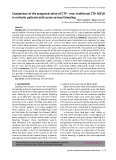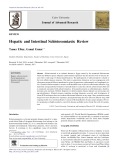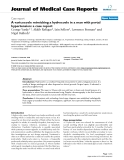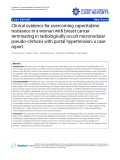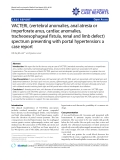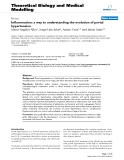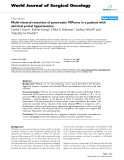
surrounding mucosa. Larger areas of ulceration may be re-
placed by granulation tissue. Mononuclear cells, eosinophils,
and few polymorphonuclear leukocytes infiltrate the mucosa.
The supporting tissue is composed of fibrous connective tissue
and muscle derived from the muscularis mucosa. Blood vessels
may be present in large numbers but diminish as fibrosis pro-
gresses. Viable and nonviable eggs are present in all polyps
[34].
Clinical manifestations
Schistosomal colonic polyposis affects mainly adult males.
This male predominance is related to greater employment in
agricultural work and higher rates of contact with water [35].
The primary presenting symptoms are usually tenesmus and
the rectal passage of blood and mucous. Diarrhea, abdominal
pain, dyspepsia, and irreducible schistosomal papilloma pro-
truding from the anus occur in some patients [34,36]. Malnu-
trition, weight loss, nail clubbing, pitting peripheral edema,
and pericolic masses may also be present [29,36,37]. Other
manifestations include iron deficiency anemia, hypoalbumine-
mia, protein-losing enteropathy, and rectal prolapse [37,38].
The presence of polyposis does not appear to predispose pa-
tients to the development of large bowel cancer [39,40] and
many investigators even have rejected any relationship be-
tween schistosomiasis and colorectal carcinoma, although this
view is debatable if we consider S. japonicum [41–43]. How-
ever, there is a report on a patient with sigmoid cancer coexis-
ting with schistosomiasis and the authors entailed a possible
but inconclusive role for chronic schistosomiasis mansoni in
promoting carcinogenesis of colorectal neoplasms [44].
Schistosomal appendicitis is a rare complication that can
occur in 0.02–6.3% in endemic areas (representing 28.6% of
chronic appendicitis in such region) and 0.32% in developed
countries. Its main mechanism depends on mechanical appen-
diceal lumen obstruction by adult worms rather than being a
complication from egg deposition [45].
Diagnosis
Definite diagnosis of the disease depends on certain tools as
microscopy and egg identification, serology and radiologic
findings. Other non-specific findings include eosinophilia (in
relation to stage, intensity and duration of infection), throm-
bocytopenia (from splenic sequestration) and anemia (from
chronic blood loss). Liver biochemical profile is usually normal
[46]. Demonstration of parasite eggs in stool is the most com-
mon method used for making the diagnosis of schistosomiasis
and species identification. To assess intensity of infection,
quantitative sampling of defined amounts of stools (Kato Katz
technique) is applied. Concentration techniques improve the
sensitivity of egg detection. Moreover, further slide readings
from the same stool sample using the Kato Katz technique
associated with a serological test (three slides reading and
the IgG anti-Schistosoma mansoni-ELISA technique) proved
to be a useful procedure for increasing the diagnostic sensitiv-
ity [47]. Schistosomiasis can be diagnosed also by finding eggs
in tissue biopsy specimens from rectal, intestinal and liver
biopsies [48]. However, the sensitivity of these procedures is
variable due to fluctuation of egg shedding [49].
Serologic tests can detect antischistosomal antibodies in
serum samples. The main drawback is their inability to distin-
guish between past and current active infection. However, a
negative test can rule out infection in endemic population. An-
other drawback is that they remain positive for prolonged peri-
ods following therapy making them unreliable for post
treatment follow up [46]. To solve these defects, techniques
to detect parasite antigens, in sera and stools, have recently
been developed and can identify current infection and its inten-
sity [50]. Urine dipstick diagnostic tests can detect schistosome
circulating cathodic antigen (CCA). They were tested in field-
based surveys, certainly for preschool children due to the dif-
ficulty to obtain consecutive stool samples, and provided a
more sensitive and rapid testing for intestinal schistosomiasis.
This may help in future epidemiological screening studies [51].
Sensitive and specific diagnostic methods of schistosomiasis
at an early stage of infection are important to avoid egg-in-
duced irreversible pathological reactions. Detection of free cir-
culating DNA by PCR can be used as a valuable test for early
diagnosis of prepatent schistosomiasis infection [52]. Several
studies have developed polymerase chain reaction (PCR)
methods to improve the direct detection of Schistosoma anti-
gens. These tests are done on urine, stool, or organ biopsy
samples, and involve the preparation of DNA from eggs prior
to PCR amplification [53]. Only a small volume of sample can
be used for DNA extraction, and it is dependent on chance
whether the processed sample contains ova or not. Similarly,
PCR has the same limitations as microscopy and does not pro-
vide a significant clinical benefit [49]. Another study detected
S. haematobium-specific DNA in urine with similar specificity
to detection of parasite eggs but with improved sensitivity
[54]. Hopefully, an updated PCR assay has been available
for the detection of Schistosoma mansoni DNA in human stool
samples using QIAampÒDNA Stool Mini Kit. It allows the
heating of the sample (until 95 °C) to facilitate the rupture of
the egg and cellular lysis. It also includes Inhibitex, which ad-
sorbs DNA damaging substances and PCR inhibitors present
in the fecal material. For amplification, the DNA samples
are diluted only 5-fold with good reproducibility and the study
can provide high sensitivity and specificity results [55]. Another
novel diagnostic strategy is developed, following the rationale
that Schistosoma DNA may be liberated as a result of parasite
turnover and reaches the blood. Cell-free parasite DNA
(CFPD) can be detected in plasma by PCR for any stage of
schistosomiasis [49].
Radiologically, abdominal ultrasonography plays an inte-
gral role in the diagnosis of hepatosplenic schistosomiasis.
Imaging can show periportal fibrosis, splenomegaly, portal
vein dimensions and the presence of collateral vessels. In addi-
tion, ultrasonography helps to assess degree of periportal
fibrosis by measuring portal tract thickness: Grade I if thick-
ness is 3–5 mm, Grade II if it is 5–7 mm and Grade III if it
is more than 7 mm. This method reflects the hemodynamic
changes and provides a good estimate of the clinical status
of patients who have periportal fibrosis [56]. Portal hyperten-
sion is suspected when dilatation of one or more of the portal,
mesenteric and splenic veins is detected. For the collateral ves-
sels, the most commonly described are the left and right gas-
tric, the short gastric, the par umbilical and the splenorenal
veins [57,58] Fig. 3.
Lastly, the hepatic veins in schistosomiasis can be assessed
ultrasonographically. They remain patent with normal phasic
448 T. Elbaz and G. Esmat






